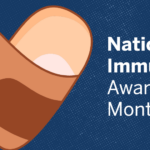National Youth Obesity Rate Holds Steady, New Data Show
Three out of 10 youth ages 10 to 17 are overweight or obese
Princeton, N.J., September 19, 2017—Roughly three out of 10 young people in the United States, 31.2 percent, are overweight or obese, according to the newest available data. Seven states—Alabama, Florida, Mississippi, North Dakota, Rhode Island, Tennessee, and West Virginia—have rates of overweight and obesity that exceed 35 percent. Only one state, Utah, has a rate under 20 percent.
The 2016 state-by-state rates for children and adolescents ages 10 to 17 were recently released on the Data Resource Center for Child and Adolescent Health (DRC) website (www.childhealthdata.org) and are reported at stateofobesity.org/children1017. This is the first update to this national data set since 2011-12.
The release of these new youth data follow the recent publication of the annual State of Obesity report by the Robert Wood Johnson Foundation (RWJF) and Trust for America’s Health (TFAH), which includes state-by-state adult obesity rates. Together, the two data sets show that obesity rates may be levelling off, but that progress could be eroded if policies are weakened or programs are cut.
At the time of the State of Obesity release in August, the leaders of RWJF and TFAH shared their perspectives:
Richard Besser, president and CEO of RWJF:
“Obesity rates are still far too high, but the progress we’ve seen in recent years is real and it’s encouraging. That progress could be easily undermined if leaders and policymakers at all levels don’t continue to prioritize efforts that help all Americans lead healthier lives.”
John Auerbach, president and CEO of TFAH:
“It’s clear that the progress we’ve made in fighting obesity is fragile—and that we’re at a critical juncture where continuation of the policies that show promise and increased support and resources could truly help bend the rising tide of obesity rates. We’re far from out of the woods when it comes to obesity. But we have many reasons to be optimistic thanks to parents, educators, business owners, health officials, and other local leaders. Our nation’s policymakers must follow their example to build a culture of health.”
To accelerate progress in addressing obesity, RWJF and TFAH urge policymakers to:
- Invest in prevention at the federal, state and local levels, including full funding for the Centers for Disease Control and Prevention and the Prevention and Public Health Fund.
- Prioritize early childhood policies and programs, including support for Head Start and the Child and Adult Care Food Program.
- Maintain progress on school-based policies and programs, including full implementation of current nutrition standards for school foods.
- Invest in community-based policies and programs, including nutrition assistance programs such as the Supplemental Nutrition Assistance Program (SNAP), and transportation, housing, and community development policies and programs that support physical activity.
- Fully implement menu labeling rules and the updated Nutrition Facts label.
- Expand healthcare coverage and care, including continued Medicare and Medicaid coverage of the full range of obesity prevention, treatment, and management services.
The stateofobesity.org site provides a new feature examining relevant policies at the state level and an interactive feature reporting on the latest obesity rates by state. The DRC website, www.childhealthdata.org, enables visitors to examine youth obesity rates by race/ethnicity, household income, and other demographic factors, as well as other relevant variables, such as physical activity rates.
About the new youth data
The new overweight and obesity rates among 10- to 17-year-olds are from the 2016 edition of the National Survey of Children’s Health (NSCH). The Maternal and Child Health Bureau (MCHB) funds and directs the NSCH, and develops survey content in collaboration with a national technical expert panel and the U.S. Census Bureau, which then conducts the survey. The NSCH uses parent reports of a child’s or adolescent’s height and weight to calculate body mass index.
The NSCH methods and sample size changed between 2011-12 and 2016, meaning it is not advisable to directly compare results across years. But the data do indicate a consistent stabilization in national and state rates of childhood overweight and obesity over the last decade. The NSCH is planned as an annual survey going forward, so these and other trends can be evaluated.
The Child and Adolescent Health Measurement Initiative (CAHMI) at the Johns Hopkins Bloomberg School of Public Health partners with MCHB in the design of the NSCH and analyzes and publishes state by state findings on its Data Resource Center for Child and Adolescent Health website, which is where the data reported here were obtained. RWJF and TFAH worked with CAHMI to announce the latest obesity rate data.
Overweight and Obesity Rate Among Youth Ages 10-17 by State, 2016
|
1. Tennessee |
37.7 |
18. Georgia |
32.2 |
35. Minnesota |
27.7 |
|
2. North Dakota |
37.1 |
19. Michigan |
32 |
36. Colorado |
27.2 |
|
3. Mississippi |
37 |
20. New York |
31.8 |
37. Virginia |
27.2 |
|
4. Florida |
36.6 |
21. New Jersey |
31.7 |
38. Wyoming |
27.1 |
|
5. Rhode Island |
36.3 |
22. Pennsylvania |
31.7 |
39. Illinois |
27 |
|
6. Alabama |
35.5 |
23. South Dakota |
31.4 |
40. Arizona |
26.9 |
|
7. West Virginia |
35.1 |
24. California |
31.2 |
41. Massachusetts |
26.6 |
|
8. Louisiana |
34 |
25. Delaware |
30.9 |
42. Alaska |
26.3 |
|
9. Arkansas |
33.9 |
26. Kansas |
30.9 |
43. Idaho |
26 |
|
10. Indiana |
33.9 |
27. North Carolina |
30.9 |
44. Hawaii |
25.5 |
|
11. District of Columbia |
33.8 |
28. Nevada |
30.5 |
45. Washington |
25.5 |
|
12. Oklahoma |
33.8 |
29. Connecticut |
30.2 |
46. New Mexico |
24.9 |
|
13. Maryland |
33.6 |
30. Iowa |
29.9 |
47. New Hampshire |
23.8 |
|
14. Kentucky |
33.5 |
31. Wisconsin |
29.5 |
48. Montana |
23.2 |
|
15. Texas |
33.3 |
32. Missouri |
29.4 |
49. Vermont |
22.2 |
|
16. Ohio |
33.1 |
33. Nebraska |
29.2 |
50. Oregon |
20.3 |
|
17. South Carolina |
32.9 |
34. Maine |
28.2 |
51. Utah |
19.2 |
###
Trust for America‘s Health is a non-profit, non-partisan organization dedicated to saving lives by protecting the health of every community and working to make disease prevention a national priority.
For more than 40 years the Robert Wood Johnson Foundation has worked to improve health and health care. We are striving to build a national Culture of Health that will enable all to live longer, healthier lives now and for generations to come. For more information, visit www.rwjf.org. Follow the Foundation on Twitter at www.rwjf.org/twitter or on Facebook at www.rwjf.org/facebook.

